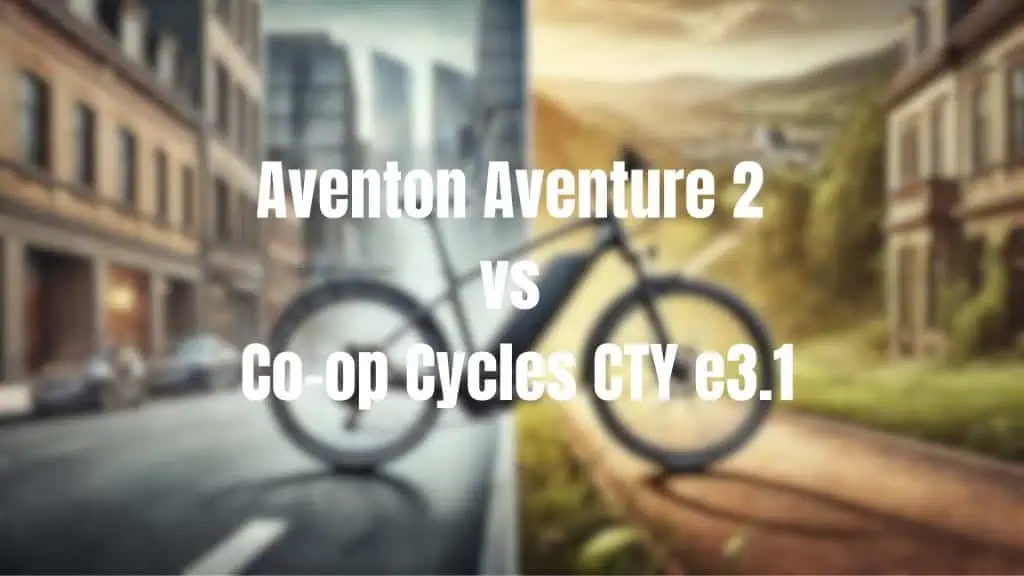Aventon Aventure 2 vs Co-op Cycles CTY e3.1

In the competitive electric bike market, the Aventon Aventure 2 and the Co-op Cycles CTY e3.1 represent two different approaches to e-bike design. Both offer unique features tailored for different riding styles. Let’s compare these two models to help you determine which might be the better fit for your needs.
Comparison Table
| Feature | Aventon Aventure 2 | Co-op Cycles CTY e3.1 |
|---|---|---|
| Price | $1,799.00 | $4,059.00 |
| Motor Type | Rear hub motor | Mid-drive motor |
| Power | 750W | 250W |
| Brakes | Hydraulic disc | Mechanical disc |
| Pedal Assist vs. Throttle | Pedal-assist | Pedal-assist |
| Weight | 77 lbs | 60 lbs |
Price and Value
- Aventon Aventure 2: $1,799.00
- Co-op Cycles CTY e3.1: $4,059.00
The price difference between these two models is substantial. The Aventon Aventure 2 is significantly less expensive, coming in at less than half the price of the Co-op Cycles CTY e3.1. This $2,260 difference is a major factor to consider and could be a deciding point for many buyers.
Motor Type and Power
- Aventon Aventure 2: Rear hub motor, 750W
- Co-op Cycles CTY e3.1: Mid-drive motor, 250W
While the Aventon Aventure 2 boasts a more powerful 750W rear hub motor, the Co-op Cycles CTY e3.1 uses a 250W mid-drive motor. Despite the lower wattage, mid-drive motors are known for their efficiency and better performance on hills due to their ability to leverage the bike’s gears. The Aventure 2’s higher wattage will likely provide more raw power, especially on flat terrain.
Brakes
- Aventon Aventure 2: Hydraulic disc
- Co-op Cycles CTY e3.1: Mechanical disc
The Aventon Aventure 2 features hydraulic disc brakes, which generally offer better stopping power and require less maintenance than mechanical disc brakes. The Co-op Cycles CTY e3.1 uses mechanical disc brakes, which are still effective but may require more frequent adjustment and might not provide quite the same level of modulation as hydraulic systems.
Pedal Assist vs. Throttle
Both bikes use pedal-assist systems, meaning they provide power only when you’re pedaling. This creates a more natural riding experience and can help extend battery life compared to throttle-only systems.
Weight
- Aventon Aventure 2: 77 lbs
- Co-op Cycles CTY e3.1: 60 lbs
The Co-op Cycles CTY e3.1 is 17 pounds lighter than the Aventon Aventure 2. This weight difference could be noticeable when handling the bike off the road, such as when lifting it onto a bike rack or carrying it up stairs.
Additional Considerations
- Intended Use: The Aventon Aventure 2, as its name suggests, is likely designed for more adventurous riding and potentially off-road use. The Co-op Cycles CTY e3.1, with “CTY” in its name, is probably more focused on urban riding and commuting.
- Motor Placement: The mid-drive motor on the Co-op Cycles CTY e3.1 provides a more balanced weight distribution and potentially better handling, especially on steep inclines.
- Range: The lower-powered motor of the Co-op Cycles CTY e3.1 might offer a longer range, although this would depend on the specific battery capacities and usage patterns.
- Brand and Support: Aventon has been making a name for itself in the e-bike market with quality products. Co-op Cycles is REI’s house brand, which comes with the backing of REI’s customer service and their excellent return policy.
Which is Better?
The choice between these two e-bikes depends on your specific needs and preferences:
- Budget: If price is a major factor, the Aventon Aventure 2 is the clear winner, offering significant savings.
- Power vs. Efficiency: The Aventon Aventure 2 offers more raw power, which might be beneficial for riders in very hilly areas or those who frequently carry heavy loads. The Co-op Cycles CTY e3.1, with its mid-drive motor, likely offers better efficiency and more natural-feeling assistance, especially on varied terrain.
- Weight: The Co-op Cycles CTY e3.1 is lighter, which could be important if you need to carry the bike frequently.
- Braking Performance: The Aventon Aventure 2 has an edge with its hydraulic disc brakes.
- Intended Use: For more adventurous riding or off-road use, the Aventon Aventure 2 might be more suitable. For primarily urban commuting, the Co-op Cycles CTY e3.1 could be the better choice.
In conclusion, the Aventon Aventure 2 offers exceptional value, higher power output, and potentially better suitability for off-road adventures at a much lower price point. It’s great for budget-conscious riders who want a powerful e-bike for varied terrain.
The Co-op Cycles CTY e3.1, while significantly more expensive, offers the efficiency and performance of a mid-drive motor in a lighter package. It might be preferable for those who want a more high-end, integrated e-bike experience primarily for urban use and don’t mind paying a premium for it.
Consider your budget, daily commute, local terrain, and riding preferences when making your decision. Both bikes offer quality rides but cater to different priorities in the e-bike market.






